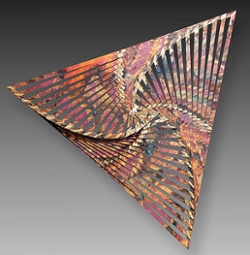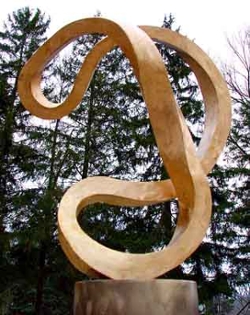Chemistry Is in the Copper with John Searles
 Rotated Triangles come to life as 16 layers of copper with salt and fire patina and is 55 inches in length on each of its three sides. Its home is in St. Louis, Missouri.
Rotated Triangles come to life as 16 layers of copper with salt and fire patina and is 55 inches in length on each of its three sides. Its home is in St. Louis, Missouri.Photo courtesy of John Searles.
The universe, mathematics and chemistry all play a curious role with one another in the metal sculptures and wall art crafted by John Searles.
No stranger to moving around, Searles has traveled a great deal throughout his life. He was born in Kansas, went to junior high in Buffalo, NY, high school in Boston, MA, and then moved to Columbia, MO to earn a chemistry degree with a minor in art at the University of Missouri. He’s well-seasoned in living in different places and taking in what different cities and the natural settings outside of them have to offer for inspirations at the hands of metal.
“My father and mother had advanced degrees in chemistry—they met in chemistry class—so it was expected of me, though I had minimal interest in it at the time and just wanted to focus on my art studies,” he says. “Now I count myself lucky for that chemistry education and every month consume several science magazines.”
After leaving a paint research lab to create art, Searles began to see, years into his new career, that his time spent studying chemistry was instrumental in helping him create his signature patinas.
Today, Searles has his studio and home in a former tool factory about a half-mile from Lake Michigan.
He describes his art as abstract yet very rich with incredible detail.
His dive into metal musings began about 20 years ago.
“I was doing photography and painting, and I wanted to do something outside, like with big installations,” he says.
“I’m a person who is not afraid to fail,” he adds about his self-taught background with metal.
 Silicon bronze with a clear coat takes shape as Bronze Mobius and is housed at the The Westin Book Cadillac Detroit, a hotel in Michigan.
Silicon bronze with a clear coat takes shape as Bronze Mobius and is housed at the The Westin Book Cadillac Detroit, a hotel in Michigan.Photo courtesy of John Searles.
In the early days, he began simply with weaving copper and didn’t initially know how to braze or solder; he hot-glued his first piece together, and it fell apart three days later.
But in time, his weavings for walls and other sculptures grew gracefully in their final care at his fingertips.
And some of his larger pieces, often made of silicon bronze, are in several different sculpture gardens around the country.
The sculptures he adds to frequently walked through gardens in cities often seem to crawl upward in a rising spiral, mapping briefly horizontally and swirling their way toward the sky in thick sections of silicon bronze.
His brass tiles, done in varying sizes, are often ordered in multiples, which he frames before shipping.
Some of the tiles tend to almost mimic the whirring distant appearance of gaseous planets but in a brilliantly colorful approach, all their own.
Layering sections of imperfectly shaped rectangles and squares for wall pieces, testing out different surface textures and final shades is another way he brings his metals new lives.
He estimates that his work has been shipped to around 75 percent of the U.S.
For purchasing copper, Searles places his orders through Chris Industries, Inc. in Illinois and Nimrod Copper Co. in Virginia.
He sources brass from OnlineMetals.com based in Seattle.
Searles participated in art shows from 1993 until 2007 and then began to work primarily from internet sales because their demand started to support his workload enough that he never needed to leave home to land a new client.
“Copper is just amazing—the colors it takes and what the flame and fire can do with patinas,” he says.
Searles notes that how a specific color turns out on the surface of copper is determined by the layers of oxide involved.
“I’ve really been drawn to music all of my life,” he says, referencing how it, along with math and metal, have interesting interplay in the cosmos and in the design of his work.
Silent songs seem to carry through the metal he repurposes into art.
“Math is the basis of all patterns in the universe,” he reflects in explaining how calculating colors and the chemistry of shape and form are a backdrop in his process and final pieces.
Resources:
Also in this Issue:
- The Serendipitous Bronze Sculptures of Storm King Art Center
- Chemistry Is in the Copper with John Searles
- Capturing The Melodies And Colors of Copper
- AJ's Copper Garden: Where Dreams Come True
- Rare Kopper Kart Pickup on View at America on Wheels Museum
